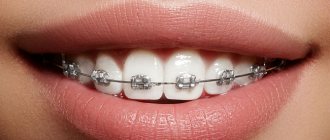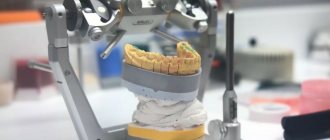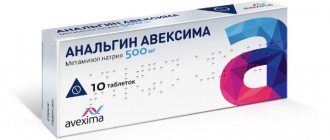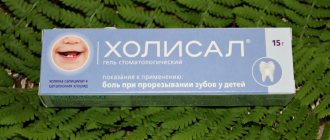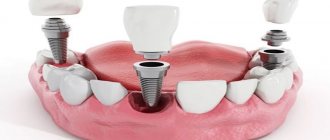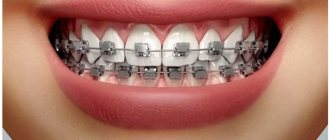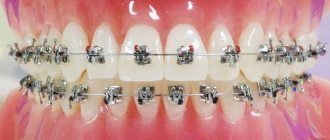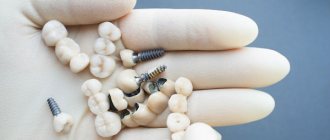Self-ligating braces are a revolution in the field of orthodontics. If in classical designs the arch is fixed on the plates using ligatures (rubber bands or rings), then in non-ligature systems there are metal locks on the brackets that hold the arch in a certain position. In addition, they independently choose the force of pressure on the teeth, tightening or loosening the tension of the arch if necessary.
Compared to conventional ligature constructions, self-ligating systems are characterized by higher comfort (there is no pain, as after changing ligatures), as well as simple hygienic care. From the point of view of the effectiveness of treatment, ligatures, with a competent and professional approach, are in no way inferior to self-ligating ones, however, the final decision on the choice of design should be made only by the attending physician, depending on the pathology of the bite.
Advantages and disadvantages of self-ligating braces
| Advantages | Flaws |
|
|
Advantages of non-ligature systems
Self-regulating braces are designs without ligatures, that is, without rubber bands that secure the arch. Thanks to this feature, the friction of the arc in the lock groove is reduced several times. The ligature-free design involves fixing the arch using clasps located on the bracket itself. Due to the absence of a ligature, the structure on the teeth looks less bulky and can be practically invisible to others.
On the left are ligatures, on the right are self-ligating metal ones
Ligature-free braces have the following advantages over their counterparts with rubber bands:
- More aesthetic appearance;
- They are much easier to clean;
- Quick adjustment period;
- They are more comfortable for the patient;
- They provide shorter treatment times;
- Simple process of installing and removing the arc;
- Less frequent visits to the dentist are necessary.
Despite the large number of advantages, this braces system requires completion of treatment using a rectangular arch. However, this is a problem for the specialist, not the patient. The latter won't even notice it.
Types of self-ligating bracket systems
By location
Self-ligating braces can be either vestibular (located on the outside of the teeth) or lingual (located on the side of the tongue). The first option is more affordable, the second is the most aesthetically pleasing of all possible, since the systems are completely invisible on the teeth. They are even called “invisible” braces. Naturally, they have a high price.
Based on materials
Ligature-free systems can be made of various materials. The most common is metal (alloys of inexpensive metals or containing gold, titanium). More aesthetic materials are ceramics and sapphires. When choosing a self-ligating design, each bracket plate is supplemented with a metal groove and/or lock, which will ensure retention of the metal arch. This option is less aesthetic, but more effective, since the arc force on a smooth ceramic surface is noticeably reduced.
By type of design
Self-ligating bracket systems are considered to be the standard of orthodontic treatment. However, in practice, everything is not so smooth: they are suitable only for some patients, however, like any other construction for correcting the bite.
There are two types of ligation - active (the arch is tightly clamped inside the staple) and passive (the arch slides freely). Each of them is used to solve specific problems - tooth rotation, movement back and forth or sideways. While ligature systems allow you to easily adjust the type of ligation, in self-ligating constructs it is initially one: active or passive. With such an approach, at a certain stage the treatment may reach a dead end - which is why the indications for the use of these braces are strictly defined.
Today there are brace systems that allow you to change the type of ligation - from non-ligature to ligature, from passive to active, thereby solving even the most complex problems.
Popular brands
There are not many self-ligating braces on the market, but the patient has a very good choice: these are lingual systems, vestibular metal or aesthetic ceramic, sapphire systems. They are produced by various companies. Let's look at the most popular brands, ranked by cost (in increasing order):
- Prodigy (USA): inexpensive self-ligating braces made of metal. Strong, durable and efficient, easy to install and remove,
- Lotus (USA): they are almost a complete analogue of the Damon system, but are more affordable. Made of metal, have a low profile, which increases comfort,
- Quick (Germany): metal systems without nickel content, which minimizes the risk of allergic reactions. They have a low profile, which makes them quite comfortable and reduces the adaptation time,
- Empower (USA): braces that are made of metal or ceramic, complemented by a metal clip. Metal systems have a low profile, ceramic systems have high aesthetics and efficiency due to the addition of a metal groove,
- Experience (Germany): a line of some of the most effective self-ligating systems, which are available in three modifications - metal (classic and mini) and ceramic. Equipped with a heavy-duty innovative kink-resistant latch,
- Damon (USA): a line of braces that are made of metal, sapphire or ceramic. Equipped with a cover of a special patented design, which allows you to easily open and close the lock without chipping or breaking, even with frequent replacement of the arches,
- QuicKlear (Germany): ceramic braces that are equipped with both a ceramic and a metal lock. Aesthetic and quite effective - treatment periods with systems are from 1.5 years,
- In-Ovation (USA): a series of braces made from metal or ceramics. Metal systems can also be vestibular or lingual. Some of the most expensive designs, which are highly effective and allow you to correct your bite as quickly as possible,
- 2D (Germany): lingual braces that have a template shape. Due to this, their price is quite low compared to other similar systems. They have a low profile and a polished surface, so it won’t take much time to get used to them,
- SmartClip (USA): metal braces that are made of nickel and titanium, therefore minimizing the risk of breaking the locking fastener,
- Clarity SL (USA): made of ceramic, complemented by a metal groove and lock. Due to this, it is possible to maintain aesthetics and increase the efficiency of the system,
- Insignia (USA): vestibular metal braces that are developed individually for each patient directly in a company located in the USA. Due to the accuracy and predictable results, they are quite expensive,
Installation Features
Installing braces is a serious procedure that requires preparation from both the patient and the doctor. After conducting diagnostics, which includes orthopantomography, teleradiography, taking photographs of the face and teeth, taking impressions of teeth, the orthodontist draws up a treatment plan. The entire preparatory stage may require from several hours (if the clinical case is simple) to two weeks (if the clinical case is complex). If the patient has caries and any other inflammatory lesions, they must be cured. Thus, sanitation of the oral cavity is a condition that must be fulfilled before installing braces. In addition, hygienic cleaning is mandatory. Installation of self-ligating systems requires on average about one and a half hours and is carried out in several stages:
- fixing the bracket on each individual tooth using bond;
- installation of a power arc and combining brackets with each other;
- arch correction during treatment.
Self-ligating braces: patient reviews
“The patient should always remember that the doctor is treating, not braces! And even the most expensive braces may not be effective in the hands of an orthodontist who doesn’t know how to do anything. This is exactly what happened to me. Initially, I installed regular metal braces. A YEAR passed, but nothing changed. Or rather, the teeth moved apart, of course, but the result was not what was needed. I went to another doctor, took off the braces, and put them on again... now without ligature. And in six months we corrected all the mistakes of the past. So there is something to compare with - heaven and earth! Self-ligating ones are just a fairy tale; they don’t make your teeth hurt so much! Although, of course, it’s different for everyone, maybe it happened like this for me because I’ve already been treated before.”
Marina Kochneeva, Ekaterinburg
“My doctor was categorically against self-ligating ones, supposedly ligating ones are better. I chose another doctor because going to the orthodontist all the time is too difficult. I didn’t regret it at all - there was practically no pain, it was comfortable, convenient. I've already counted about ten pluses. There are also a couple of disadvantages, of course, and one of them is the price. But the systems are working, I’ve been wearing them for 7 months and still have another month left according to forecasts. At first I rarely visited the doctor, but in the middle they changed the arches almost every month.”
Mikaellina, from correspondence from forums
“I regret my choice a little - I installed the usual metal ones, the cheapest ones, but now I pay a couple of thousand every month for changing the rubber bands + the arches also need to be changed periodically, this is even more expensive. I'm afraid I'll overpay at the end of treatment! My colleague doesn’t pay that much for self-ligating ones, it feels like he doesn’t go to the doctor at all...”
Ksenia S., 28 years old, Moscow
Cost of self-ligating braces
Self-ligating braces are quite expensive. This is explained by the fact that manufacturers have to invest heavily in research and testing of systems to achieve their maximum efficiency. Non-ligature braces must work independently, so for such “smart” designs the patient has to pay 2-3 times more than ligature systems.
| Brand name | Cost, rub. |
| Metal braces | |
| SmartClip (USA) | from 100000 |
| Quick (Germany) | from 60000 |
| Damon 3MX, Damon Q (USA) | from 100000 |
| Insignia (USA) | from 90000 |
| Prodigy (USA) | from 40000 |
| Empower Metal (USA) | from 60000 |
| Lotus (USA) | from 50000 |
| In-Ovation R (USA) | from 80000 |
| Experience metal (Germany) | from 50000 |
| lingual Incognito (USA) | from 400000 |
| lingual 2D (Germany) | from 80000 |
| lingual In Ovation L (Germany) | from 100000 |
| lingual Win (Germany) | from 360000 |
| Ceramic braces | |
| Clarity (USA) | from 110000 |
| QuicKlear (Germany) | from 80000 |
| Damon-3 (USA) | from 90000 |
| Empower Clear (USA) | from 80000 |
| In-Ovation C (USA) | from 90000 |
| Experience ceramic (Germany) | from 80000 |
| Sapphire braces | |
| Damon Clear (USA) | from 90000 |
Popular questions and answers about self-ligating braces
Is it worth overpaying for self-ligating systems? Are they really more effective?
The technology of correcting the bite and position of teeth through constant but gentle pressure allows treatment to be carried out with the least risk and greater efficiency. However, this does not mean that correcting a bite with self-ligating systems will take less time - depending on the initial situation, the condition of the roots of the teeth, their position, the quality of the bone tissue; treatment, on the contrary, can be longer. In any case, the choice of system for treatment should primarily be up to the orthodontist. Self-ligating systems are more comfortable, do not lead to such frequent inflammation of the mucous membranes, do not cause acute painful sensations, and moreover, they are easier to care for - so the high price is completely justified.
Why are self-ligating braces more expensive?
Ligature-free braces have a more complex design and operating mechanism, which makes them more expensive. In addition, systems often fall into the aesthetic category, that is, they are created from expensive ceramics and sapphires, complemented by metal grooves. This also affects the cost.
Habituation and care features
Modern systems are small in size. Therefore, it is easier for patients to get used to them. There may be discomfort in the first days after installation. If lingual braces are installed, then sometimes there is a distortion of diction. Over time, the discomfort goes away, and the structures stop interfering.
Self-ligating systems for correcting teeth do not injure the gums and oral mucosa. Their use is more comfortable for the patient.
Caring for self-ligating structures involves:
- Brushing your teeth after every meal.
- It is necessary to use special brushes and cleaners.
- Use floss and rinse aids.
On a note!
Compared to ligature braces, care for non-ligature braces is simpler. These systems are less likely to lead to the formation of plaque and caries.
